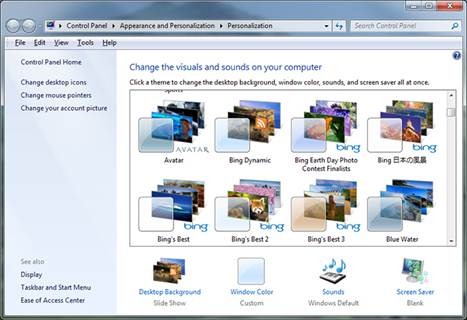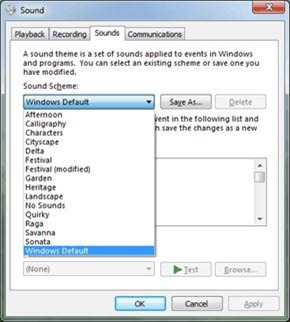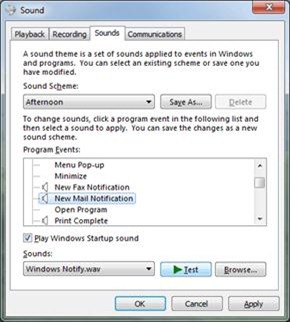If you haven’t yet checked out the 14 sound-schemes included in Windows 7, you should. Working with the small team that produced the Windows 7 sound-schemes was one of the coolest and most fascinating projects I’ve ever been a part of. I think what the audio producer and musicians created is small but beautiful, and changes the Windows experience in a subtle but distinctive way.
A Windows sound-scheme is a set of sounds that signal certain events, like starting up and shutting down Windows or getting a new email. Here’s how you can see the sound-schemes that are available and change them.
To get to the Sounds dialog box, click Sounds in Personalization:
Click the Sound Scheme dropdown menu, and choose the sound scheme you want to try out. Click Apply or OK.
You can also try out individual sounds without applying the sound-scheme to your system, by choosing the individual sound you want to hear, and then clicking Test. (If there is no speaker symbol next to the Program Event name, there is no sound currently associated with that event.)
Something a lot of people don’t know is that there is an intentional auditory language to Windows, just as there is a visual one. If you’ve used Windows for a while, you know what the little envelope or printer icon on your Taskbar means – they’re recognizable visual symbols that indicate certain events or states. The same is true of the sounds that are associated with various events, such as a new email alert or a low battery warning. Without even thinking about it, you learn to recognize that two descending notes (E to A) mean that a device has been disconnected.
Each Windows sound has a specific, composed “melody” that is consistent across the various sound schemes. In addition to the instruments used for each sound, it is the pitches (how high or low), intervals (ascending or descending, and how far), rhythm or emphasis, and timing (slow, fast, simultaneous) between the notes that helps mark the difference between a “new mail” event and “a new device was plugged in” sound. For example, here is the notation for the Device Connect and Disconnect, Windows Log Off, and New Mail sounds:
Well, the challenge we had in developing sound-schemes based on various global musical traditions is that we had to remain true to the style and instrumentation of each of the different musical cultures while also making sure that all the sounds still spoke the Windows audio language correctly. We didn’t want users having to re-learn whether a particular sound or series of notes meant “I’ve got new mail” or “my battery is getting low.” So there was a very, very delicate balance to hit, in compromising between the expressive style and tonality of each musical form and the timing and progressions required by the Windows brand guidelines.
A few of the sound-schemes (Characters and Quirky) consist of synthetically-produced sounds and samples created using electronic music synthesizers, but the sound-schemes based on various global musical styles and traditions are really real. What I mean is that the sounds you hear were created on real instruments, played by master musicians from each musical tradition and recorded live in the studio. But it goes even further than that; we also worked with an ethnomusicologist to ensure that our mini-interpretations of each musical style (and they ARE mini… each sound in the sound-schemes is only a few notes long!) were as authentic and faithful as possible, respecting the vocabulary, instrumentation, timbres, and “language” of each musical tradition.
Here are the Windows 7 sound-schemes that are based on musical traditions:
|
Name |
Inspiration |
Instruments |
|
Afternoon |
“Here Comes the Sun” guitars, James Taylor, Beatles |
12 string Taylor acoustic and 12 string Rickenbacker electric guitar |
|
Calligraphy |
Solo instruments of eastern Asia |
Gayaguem, erhu, and shakuhachi, gamelan and other bells and percussion |
|
Cityscape |
Smoky jazz club, slightly retro |
Piano, vibes, upright bass, brushed drums and percussion |
|
Delta |
American roots music (blues, country, Dixieland jazz, etc) |
Dobro, banjo, harmonica, electric slide guitar, acoustic guitar, electric bass |
|
Festival |
Mostly Samba and Mariachi influences, with Peruvian woodwinds/flutes |
Mariachi trumpets, Escolas de Samba percussion/drum ensemble, tango piano/bandoneon, Andean/Peruvian flute, steel drum |
|
Heritage |
Classical Spanish guitar; Andrés Segovia |
Nylon-stringed acoustic guitar, played in classical Spanish style |
|
Landscape |
Aaron Copland, pastoral orchestral tones |
French horns, glockenspiel/bells, bassoon, viola and violin textures |
|
Raga |
Instruments of the Indian region |
Sarod, sitar, tabla, tambura, bamboo flute, sarangi, Indian percussion |
|
Savanna |
The musical traditions of sub-Saharan Africa, South and West |
Kalimba, mbira, African percussion and large drums, kora, talking drum, djembe, balafon, woodflute |
|
Sonata |
Antonio Vivaldi; solo violins, small chamber strings and orchestral sounds |
Solo violin, with small group viola and cello, woodwinds, orchestral percussion |
I really hope you will give them a listen. I am sure it would surprise you how much music was recorded, and how many versions of each of the sounds we went through in arriving at the final sets. My one regret about this project was the thousands of fantastic out-takes we couldn’t include! I just wish I could share with you some of the unused tracks from the various jam sessions.
To learn more about changing sound schemes, changing individual computer sounds, or renaming a sound scheme, see “Changing Windows 7 sounds.” There are also some great articles and blog entries on MSDN. Take a look at these:
Last but not least, I want to give my thanks and admiration to Steve Ball, Dave Gross, and Matthew Bennett, who made this project a reality. It was fantastic working with you!





